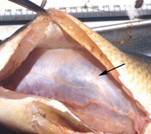|
"Your gateway to
understanding |
Largemouth Bass Virus (LMBV)

- First discovered in Florida in 1991
- Unknown how this virus spreads
- Reducing fish stress can greatly reduce virus’ effect
Largemouth Bass Virus (LMBV) was first discovered in Florida’s Lake Weir in 1991. In 1995, the second case of LMBV was reported in South Carolina when an estimated one thousand largemouth bass died between July and September. As of 2006, LMBV has been found in wild fish populations from 15 states. Fish kills have not occurred in every lake where the virus has been found. LMBV is now known to exist in Oneida Lake.
LMBV occurs naturally in largemouth bass, smallmouth bass, bluegill, redbreasted sunfish, white crappie, and black crappie, but symptoms and death only occur in adult largemouth bass. Once infected, largemouths with LMBV accumulate a yellow to brown, waxy residue in their swim bladders. No external lesions (sores) develop, but individuals that are about to die are often found swimming upside-down in circles at the surface.
Currently, researchers do not know how LMBV is spread. Anglers may transport the virus in live-wells of boats (where the disease can live for at least 4 hours), or the virus may spread through amphibian migrations, largemouth bass stocking, or fish to fish contact. LMBV only becomes lethal when fish are subjected to stressors such as high water temperature, low dissolved oxygen, and handling by anglers. Several populations of healthy largemouth bass are known to carry the virus without any apparent harm to the fish, and infected fish that appear healthy and unstressed have not been known to die as a result of the virus.
The number of bass that die from LMBV is low in comparison with the general population of a body of water. Although fishing may be poor for a short time following a fish kill, it is thought that the virus has no long-term effects on largemouth bass populations. The fish are safe to eat, though scientists recommend that all fish be thoroughly cooked as a precaution.
LMBV cannot be eradicated in wild fish populations. However, anglers can learn ways to reduce its spread and learn to minimize its impacts. Fish or fish parts should not be transferred from one lake to another, and anglers should disinfect live-wells by wiping them down with a solution of 1/8 cup bleach per gallon of water and then rinsing after five minutes. Stress should be reduced (by quick landing and unhooking in water) when catch-and-release is practiced, and fishing tournaments should be conducted during cooler weather to reduce environmental stresses.
To learn more about LMBV ...
